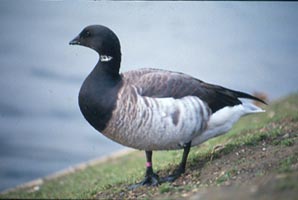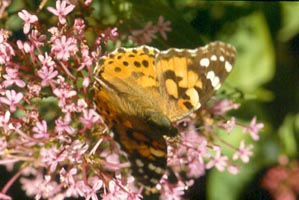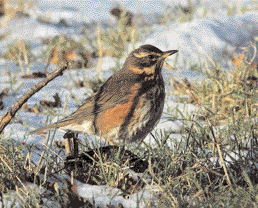| Dalkey Tidy Towns |
  |
| Dalkey Tidy Towns |
  |
Wildlife
Newsletter for the Township of Dalkey October 2010 - Michael Ryan |
|
Although it was inevitable it would one day be developed for
building I was still sad to see a planning application appear on a little
area of walled land which I’d walk past every day. An old walled orchard,
which had got very overgrown in recent years it, had long ago stopped producing
apples and cherries in enough quantities to make it worth anyone’s
while to try and pick them. It had become impenetrable with a mass of brambles
growing through the trees. But while it was ignored by man, it proved a great
haven for wildlife. Bullfinches, signalling their presence by their plaintive
little call were regular visitors all year round feeding on the buds and
berries. Every summer in recent years it has hosted a singing male Blackcap,
the dense greenery being an ideal nesting habitat and I’d be surprised
if there wasn’t a family of blackcaps nesting in there. Blackbirds
and Songthrushes also serenaded in the springtime from the apple and cherry
trees. We’d often seen foxes squeezing through the bars of the gate
and many years ago saw a badger there during the daytime. But it was in the
late eighties when the orchard had its most spectacular visitors. |
|
It was mid winter and we had just had a very heavy fall of snow. All of Western Europe and the UK were, as usual, getting far heavier falls then us but it was one of the biggest whiteouts we’d had in years, just like last winter. Crunching my way up the road through the fresh snow in that low light you get during snowfalls I saw a flurry of activity in the apple trees. At that stage it was still a well-defined orchard with low grass between the trees and there was still much of autumn's harvest on the trees. On every level of the trees and hopping around on the ground were Fieldfares, large members of the thrush family which breed in northern and Eastern Europe. We saw quite a few of them on their breeding grounds in spring when we were in Poland a few years ago. They move in large numbers to Western Europe in the wintertime when the land gets frozen in their breeding grounds. They do come to Ireland in the winter, usually moving inland but this particular day it looked like they might just have arrived off the sea maybe coming from England or Wales. Anyhow they were devouring any apples they could find, on the branches or on the ground. Fieldfares are striking looking birds with grey head and tail contrasting with brown wings and yellow bill and make a chucking like call as they move around. This flock had struck lucky and were able to feed themselves, safely secured in a walled garden. Sadly this little patch of nature’s time had come. I’ll be very sad when the chainsaws start and the JCB moves in. |
 Redwing Photo: Richard Coombes |
|
| Smaller birds nearer the milder coast don’t seem to have fared so badly. We saw young stonechats near White Rock this spring and a family flock of over 25 Long tailed Tits passed through the garden one day but undoubtedly there were big losses in other parts of the country. Without doubt many birds only made it through January’s big freeze by surviving off food provided in gardens. Fieldfares and Redwings wouldn’t usually come to feeders but if you have apple trees you might keep a few apples for hungry thrushes and if they do arrive just cut up the apples and throw the pieces around the lawn. When the redwings came into our garden we didn’t have too much fruit but I concocted a cake made of oatmeal and Niger seeds. I made porridge from the oatmeal then mixed the Niger seeds through it, put it in a baking dish and baked it in the oven. I wouldn’t have eaten the results myself but the redwings did. I baked a few more of these pies, they were rapidly devoured and hopefully it helped keep them alive for a few days. The Redwings migrate by night and they can often be heard flying overhead, especially on mild misty nights when they stay low to the ground. They make a ‘Tseep’ like call as they fly which is a means of keeping contact with each other. The first flocks usually arrive in the first or second week of October. |